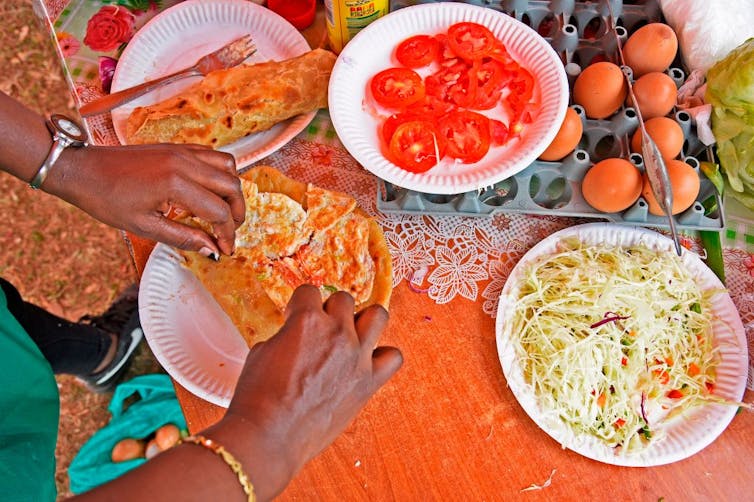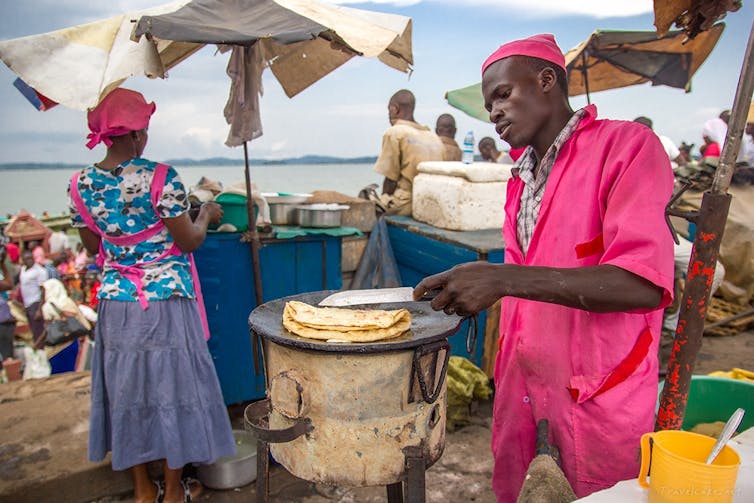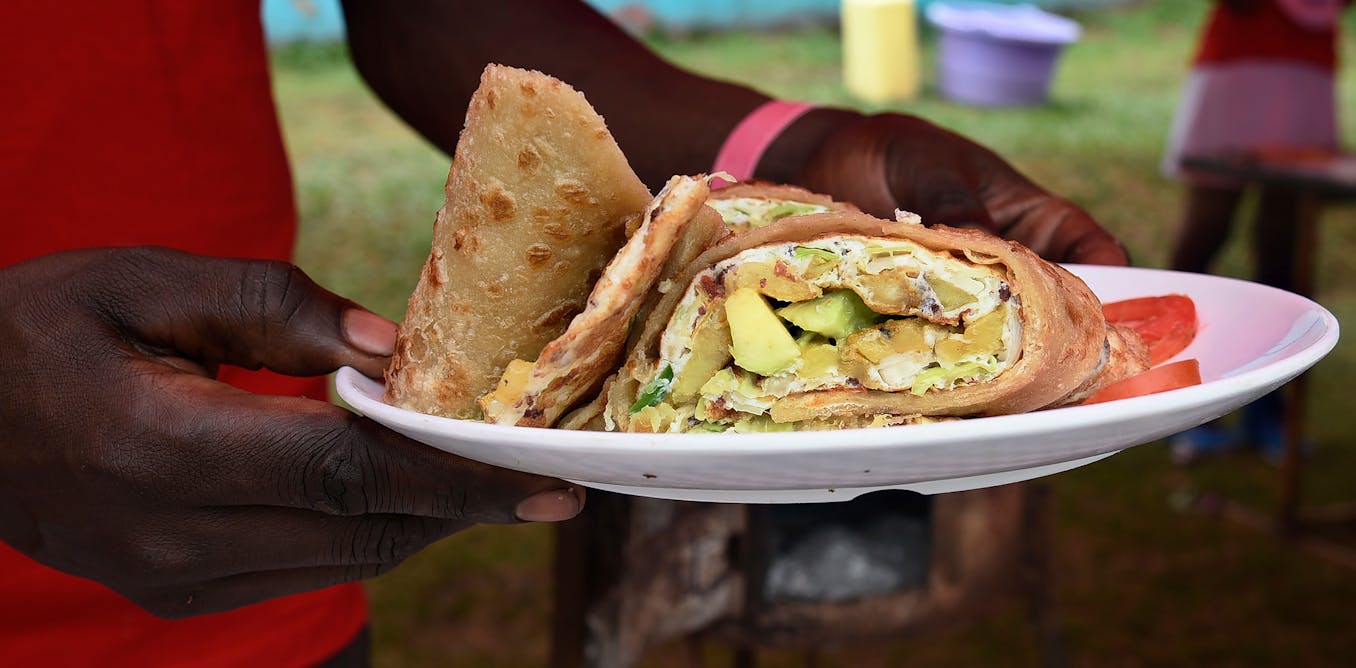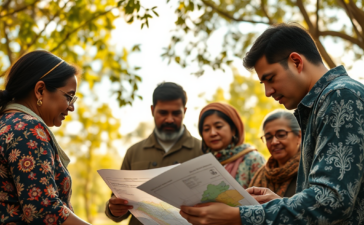What is a rolex?
A rolex is a chapati (a flatbread made from dough) rolled around fried eggs to which have been added spices and vegetables. It’s usually cooked in a frying pan on a charcoal stove. It’s prepared on order and served very hot, usually in a paper wrapper, plastic bag, or plate.
The snack is common in Ugandan urban centres in east Africa. It’s mostly prepared on roadsides at informal stalls. Artisans may simply have a table for kneading the dough, a pan for frying the eggs and chapati, a charcoal stove as a heat source and the ingredients – which can vary widely.
The snack also has more elite makers who prepare it in restaurants or mobile kitchens that add cheese, pepper and butter, among other ingredients. Rolex is commonly sold alongside vendors offering chicken, chips, roasted meat, goat, pork and beer or soft drinks.
Rolex varies depending on the region and on the demands of the clientele and ingredients available to the “chef” – much like jollof rice in west Africa. For example, some rolexes can have two or more eggs. Some can have two chapatis. Some have cooked or raw vegetables. Others might include “Indian”, “Mexican” or “Kenyan” variants, which are marketed especially at rolex festivals.
Read more:
Who invented jollof rice? Senegal beats Ghana and Nigeria to the title
This range of sizes and identities has created a diverse market, with varying prices and flavours. The nickname for a rolex can change accordingly. For example, it might be known as a double face (two eggs and two chapatis) or as a titanic (four eggs and two chapatis).
Beyond the street, rolex is made wherever people gather – be that weekly markets, funerals, prayer crusades, school events or political rallies.
Why are they so often in the news?
Rolex was ranked the best street food in Africa by CNN in 2016. That same year, Uganda’s Ministry of Tourism declared the rolex an official tourist attraction alongside the likes of mountains, the source of the Nile, lions, elephants and mountain gorillas.

Isaac Kasamani/AFP/Getty Images
In response, a non-governmental organisation called the Rolex Initiative started organising the annual Rolex Festival to draw attention to the snack. During the COVID-19 pandemic, the festival was held online. Individuals shared short videos of themselves making a rolex at home. With funding from the United Nations Development Programme, the Rolex Initiative has been organising training to upskill rolex makers. Uganda has the Guinness world records for making the biggest rolex and the fastest rolex.
How do Uganda’s media portray the rolex?
The media present the rolex in many different lights. They portray it as a source of income, a job opportunity able to employ thousands in a country with high unemployment, symbol of national pride, and a basis for creating awareness about social and environment causes.
Media also associate the making of rolex with the Basoga, a dominant ethnic group from Busoga in south-eastern Uganda.
Busoga has many residents of Asian origin, who arrived in Uganda mostly through Kenya during construction of the Uganda railway. The Basoga and others in the region had early contact with Asian cuisine. So, the rolex is seen as a symbol of Asian influence. It’s basically a Ugandan version of the Indian roti or other forms of chapatis eaten in Asia, using local ingredients such as eggs, vegetables and spices.
Rolex is portrayed as cheap, nutritious and convenient. And as fresh and healthy food for the poor. It’s a practical meal that keeps towns awake – night workers and revellers have grown to rely on the snack instead of cooking. It is a marker of improvisation.
It’s even a determinant for the price of eggs – rolex makers compete with schools and bakers for them.
The media often plays on the name being the same as the name of a luxury Swiss watch, a striking and witty way to contrast the rich and poor. This took on comic dimensions when the Swiss company patented the name “Rolex” in Uganda.
It is portrayed with pride as an export that has seen Ugandans win awards for taking the business to countries as far away as Denmark.
What else does a rolex symbolise?
The rolex is a symbol of national identity, the same way the Swiss watch is synonymous with Switzerland. It’s a Ugandan innovation and a symbol of nationalism. Ugandans travelling abroad are reported to long for a rolex and become homesick.
Rolex is a symbol of diplomacy. The increase in its price and reduction of its size due to wheat scarcity from the Ukraine-Russia war was the most significant way ordinary Ugandans felt the effects of the conflict.
The rolex is a symbol of connection between Uganda’s urban and rural areas. People (often temporarily) move to find employment as rolex makers or suppliers of ingredients for them.

Teefe Timothy Mulindwa/Wikimedia Commons, CC BY-SA
The snack breaks class and cultural barriers. It’s consumed by the rich and the poor, the educated and the illiterate, by all ethnic groups and races.
But rolex kiosks also symbolise the poor organisation of urban life in Uganda where the poor hustle to survive. Questions about food safety arise because the snack is made on the roadside and can easily come into contact with dirt. Authorities are guilty of failing to plan urban spaces to meaningfully advance the rolex businesses.
Read more:
You love amagwinya/puff puff/bofrot? Here’s a healthier version of Africa’s favourite snack
Ultimately, the rolex is used to tells the story of Uganda’s attempt to produce a unified identity around a “national meal” that caters to a wide range of ethnic and social groups.
This article written by Ivan Nathanael Lukanda, Senior Lecturer, Department of Journalism and Communication, Makerere University and is republished from The Conversation under a Creative Commons license. Read the original article.





